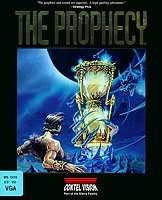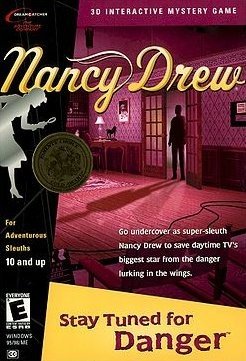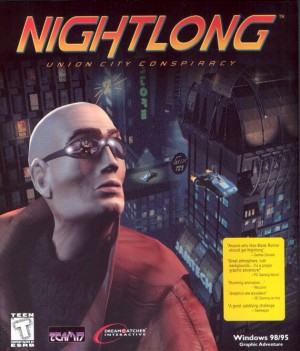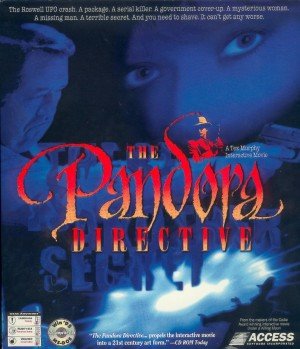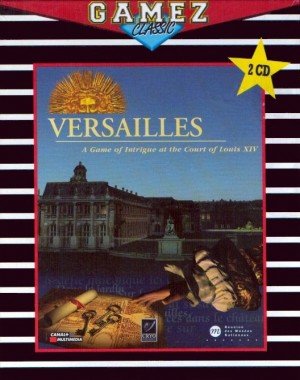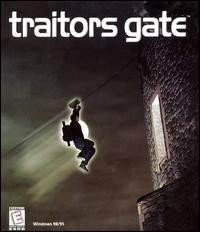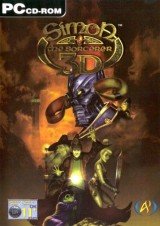Review for Ween: The Prophecy
There are cheap plugs for the developer's previous game on every other screen. The Parkinson-diseased chief wizard constantly risks losing his badly-taped fake hair and beard by wiggling his head. The villain is an unkempt brawler with an interior decorating problem. The high priestess who guards the sanctuary is probably a transvestite. The obligatory wise old man is a dotard who wears a toy helmet and only appears in rust-coloured visions, while the no-less-obligatory damsel in distress is a middle-aged soccer mom who looks bored out of her wits. And the hero's best friend is a vegetarian vampire who gorges on strawberries and defecates gold.
I must be joking, right? Well, as much as I would like to be, I'm not. And no member of Monty Python was even involved in the making of this game.
Truth be told, almost fifteen years after its release, Coktel Vision's Ween: The Prophecy still holds a special place in my heart for the unparalleled amount of kitsch that went into its execution. Of course, that's probably not what the designers intended: the wizard is supposed to look dignified, the princess attractive, and the lack of even a single joke is certainly meant to convey the gravitas of the whole thing. But when the villain's "thugs" amount to a horde of five evil mosquitoes and a demonic daisy, it is hard not to find the situation unexpectedly hilarious.
The picture would not be complete without a plot that is clichéd to the core. There is this nice little kingdom, and this big nasty villain who wants to take it over. The chief wizard is too busy complaining about his age to take care of the problem, so he just sends his grandson Ween to do the job in his stead (that's family for you). Thankfully, there exists a prophecy which, while it doesn't manage to rhyme despite its rather contrived wording, may prove an efficient solution. It involves Ween dropping three magical grains of sand into a magical hourglass, the Revuss -- a deed which, apart from making the day officially 25 milliseconds longer, will destroy the hero's enemy (and no, you can't choose to use that power on your annoying, errand-giving granddad). As you may imagine, the grains of sand cannot be just picked up on the wayside, but must be acquired by completing THE THREE TRIALS! -- or whatever they're called.
Anyway, the plot is not why you would play Ween: The Prophecy. Though there are a few further developments, they are hardly thrilling and never seem to have been taken seriously by the writers. The ending that consists of two paragraphs of white text over a black background (without even credits, since they've already been shown in the intro) is a clear sign of how relevant the plot is supposed to be.
What should you be playing this game for, then? Certainly not for its artistic merits either. The music is all right, and rather suited to the circumstances, but definitely not memorable, even though the game re-uses several cues at various points. Also, at a time when other companies had been using the Roland MT-32 for years and were starting to work with General MIDI, Coktel's decision to compose solely for the much more limited AdLib contributed to the soundtrack's lack of impressiveness. The graphics are also often unimpressive, as much because of the settings themselves (half of the game seems to take place in dull caves) as of the way they are depicted. The colours are especially noticeable, with the screens varying between monochromes and patchworks of gaudy, jarring colours. Another graphical feature of note is the use of short full motion video loops for the character portraits, which exhibit an absolutely hilarious choice of actors, make-up and costume. Still, for all the comic relief these videos unwittingly provide, they are too few are far between to justify playing the game.
Which of course still leaves unanswered the question of why one should be playing Ween: The Prophecy. No need to let the suspense last longer: it's inventory puzzles this game is all about. As a matter of fact, it feels more like a collection of inventory puzzles than a full-fledged adventure game. The odd visual perspective it chose definitely plays a part in that. Much like illustrated text adventures (think Mystery House), it features graphical depictions of each location, where you neither see your character nor play through his eyes. Instead, the screen updates "magically" when you take an item, open a door, dig a hole, etc., except that here there are animations and the text parser is replaced by a cursor and hotspots. While such a system did not seem especially awkward at the time, it might now seem surprising to people only used to the first-person / third-person dichotomy. Furthermore, this choice of perspective gives the impression that the game tries to directly confront the player with the puzzles, dropping the pretense of playing a character as an unnecessary complication -- a set-up usually only used in puzzle games.
The structure of the game reinforces this impression. It is divided into twenty-odd small sections, each one containing a couple of screens, where you have to overcome a series of obstacles using your inventory to be allowed access to the next part or "level", to use what would seem a more appropriate term. Within these small sections, the puzzle density is unbelievably high, especially since there does not seem to be much else to do, hotspots being limited to what will be used for the puzzles, and character interaction cut to the bare minimum. And no effort is spared when it comes to raising the puzzle count. Take Uki and Orbi, for instance, the twin gnomes with make-up as ridiculous as their names, who follow you in your journey. You think they're here for comic relief? Well, guess again. They are painfully unfunny (though I guess they do try), and their actual purpose is to regularly lose your items so that you can solve more puzzles to recover them! Isn't that a nice touch?
And what are those puzzles like? Well, the first thing to note about them is that they are hard. Really hard. Really, really hard. The good news is that it is not due to their being obscure or unfair. At least, not always.
Quite a few of the puzzles are definitely original and clever, and will leave you content when you finally manage to solve them. The game's designers have a strong grip on its structure, and organise things intelligently. Of particular note is the existence of progressive series of puzzles: some elements, items or characters are introduced early in the game, and then re-used later on with additional features in more complex puzzles. This contributes a cohesiveness to the game that might otherwise be lacking because of its level structure, and also allows for advanced puzzles without having to introduce all the necessary elements at the same time. Unfortunately, this may also contribute to making some puzzles feel repetitive.
The game is constructed so that it's impossible to end a level without all the items that will be necessary for the following ones, making it impossible to reach a dead end. You also can't get killed, except in the final level. This strongly-structured progression makes the game feel rather linear, though the puzzles inside each location can often be partly solved in a non-linear order. On two occasions, the game branches, letting the player solve one of two alternative levels (and then rejoin the linear path on the next one); this somewhat alleviates the perceived linearity, but remains quite a minor feature.
While Ween: The Prophecy is light on character interaction, the hero still has companions, whose help is needed to solve certain puzzles. One of them is Petroy (that's the dotard with the toy helmet), whom you can ask for advice on items and hotspots. I wish he had been left out, since he usually takes a painfully long time just to say that he doesn't know anything on the matter. This makes it tempting to stop asking for his opinion, but that will happen precisely when you're going to absolutely need the information he has. A better addition is Urm, Ween's pet bat (yes, that's the sort of vampire I was referring to; you weren't picturing... ? Eww.) When given fruit, he provides help, such as producing gold or working magic. Unfortunately, it is never really clear what he can be expected to do, often leaving the player at a loss to guess his use. Still, he certainly does not seem useless, and with his funny lines and facial expressions, he is quite an endearing sidekick.
Another original feature of note is the magic copper ball, which is quite typical of the game's flaws. You get this ball at the very beginning, and when combined with various items, it changes into useful things such as a cauldron that will be abundantly used to mix potions. This might seem like a fresh idea, but it turns out not to be a welcome one soon enough. First because it is not very clear what items will trigger the transformation. The game often feels insufficiently clued, either because the hints are given at the wrong time (long before you need them, giving you time to completely forget them), are too vague, or just not there. The often awkward translation from French also contributes to making the clues more obscure than they should be. And while you may still logically try to mix the red and blue potions together, even if you've missed the clue telling you what this would achieve, using other random items on the copper ball in hopes of getting something useful is less obvious and will definitely make you wish the clues had been clearer.
A second, related problem is that the interface is not really adapted to the game's style. Combining items is crucial (especially to transform the copper ball, or to mix potions in the cauldron it can change into), and yet it requires a tedious combination of clicks and navigating through menus. Also giving the impression of rushed-through interface design is the presence of the usual Coktel buttons for the map and hints, both of which are simply not used in the game (the former for obvious reasons when levels are never more than three screens big, the latter for no good reason -- especially since hints would be welcome in such a difficult game).
Finally, the biggest problem with the copper ball is that changing from this to that to this again quickly gets overused and tedious. By the second half of the game, too many puzzles and actions feel just like repeating the same busywork over and over again, leaving the player wondering why the inventiveness that permeated the earlier levels has suddenly dried up. The worst is reached in one of the final levels, which features a long sequence of actions that require switching back and forth between two copper ball items only to perform the same actions you had been performing in the previous level -- especially when that tedious sequence has to be repeated half a dozen times in a row!
And this final impression is unfortunately what sticks with the player. While Ween: The Prophecy is rather good at first (if you're into inventory puzzles, but if you aren't, you've probably already stopped reading anyway), it too quickly starts feeling obscure, tedious, and, well… plain unenjoyable. If you feel like playing it, I suggest you take your time with it, doing it little by little, waiting for the illumination that will allow you to progress to the next level. Using a walkthrough would be silly, since it's not really worth playing for anything other than its puzzles. If you manage to reach the end, you will probably not feel happy or content, but maybe a little proud of the achievement, which is better than nothing. And at least you'll have the FMV characters to remember.


